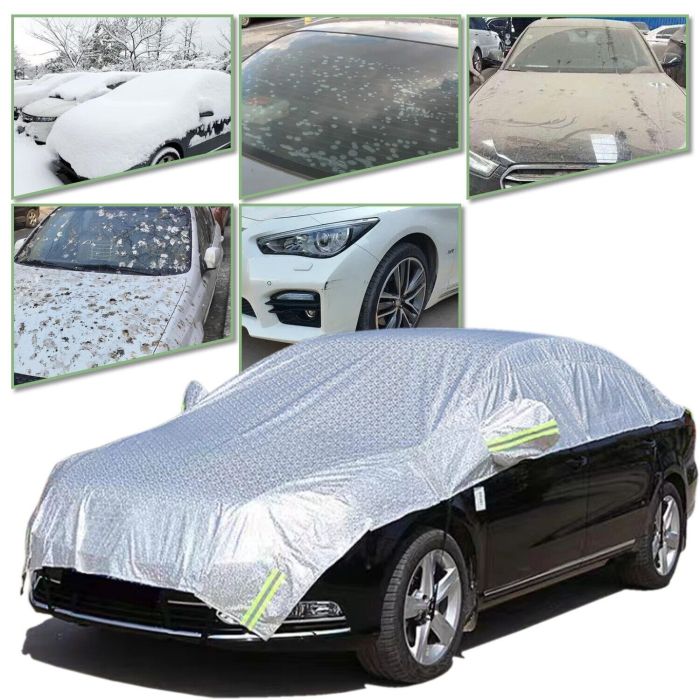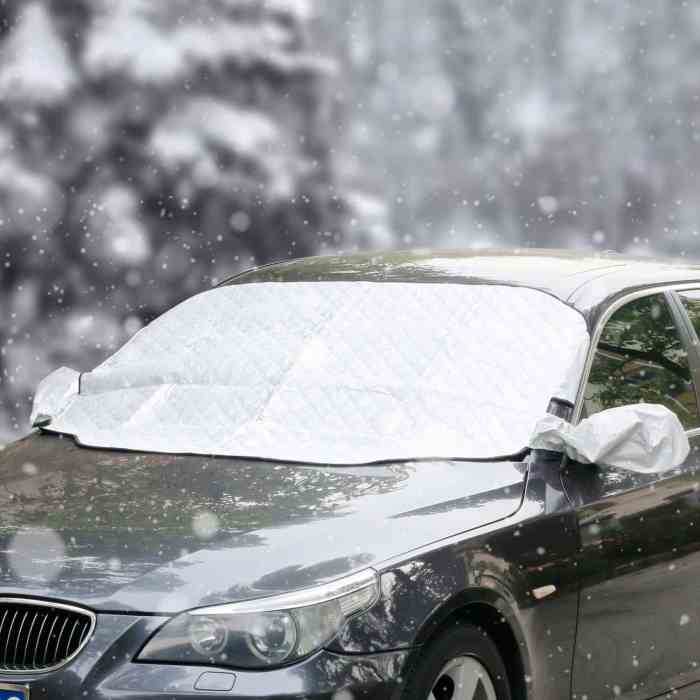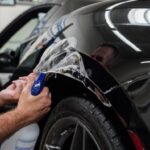Insulated car covers for snowy climates are a total game-changer, especially if you live somewhere that gets hammered with snow. Think of them as a cozy, protective blanket for your ride, keeping it toasty and safe from the elements. We’re diving deep into the science behind these covers, exploring different materials, designs, and how they actually work to shield your car from freezing temps and brutal snowstorms.
Get ready to become a car cover pro!
This guide will cover everything from the best materials and designs to practical tips on installation and maintenance. We’ll compare different types of covers, highlight their pros and cons, and even give you some FAQs to help you make the best decision for your car and your climate. Basically, we’re arming you with all the info you need to keep your car happy and healthy through even the worst winter weather.
Material Science & Design: Insulated Car Covers For Snowy Climates

Choosing the right materials and design for an insulated car cover is crucial for effectively protecting your vehicle from the harsh conditions of snowy climates. The goal is to create a cover that minimizes heat transfer, preventing both the interior from freezing and the exterior from accumulating excessive snow and ice. This involves careful consideration of material properties and design features that work synergistically to achieve optimal insulation.
Several factors influence the thermal performance of a car cover. These include the material’s inherent insulating properties, the number of layers, the presence of air pockets, and the use of reflective coatings. The manufacturing process also plays a significant role in the durability and effectiveness of the final product.
Thermal Properties of Materials
Different materials offer varying levels of thermal insulation. Fleece, for example, is a soft, fluffy fabric known for its excellent trapping of air, a key component in insulation. Polypropylene, a synthetic fiber, is often chosen for its water resistance and durability, making it suitable for snowy conditions. Reflective materials, such as aluminum or metallic coatings, work by reflecting radiant heat back towards its source, minimizing heat loss from the car’s interior.
The choice of material often involves balancing insulation performance with other factors such as cost, weight, and durability.
Design Features Enhancing Insulation
Multiple layers significantly improve insulation. A common approach is to combine a water-resistant outer layer with a fleece or other insulating inner layer. The air pockets created between these layers act as an additional insulator, further reducing heat transfer. Reflective coatings, applied to either the inner or outer layer, can enhance the effectiveness of the insulation by reducing radiative heat loss.
These coatings are particularly beneficial in situations where significant temperature differences exist between the car’s interior and the outside environment.
Manufacturing Processes
The manufacturing process of insulated car covers typically involves several steps. First, the chosen materials are cut to the desired pattern, accounting for the car’s specific dimensions. Then, layers are stitched together, ensuring strong seams that can withstand the stresses of repeated use and exposure to the elements. Reflective coatings are often applied through a specialized process, such as vacuum deposition or lamination, ensuring even coverage and durability.
Finally, the finished covers may undergo quality control checks before packaging and distribution.
Material and Design Comparison
| Feature | Fleece | Polypropylene | Reflective Coating |
|---|---|---|---|
| Insulation | Excellent (air trapping) | Good (water resistance contributes) | Excellent (reduces radiative heat loss) |
| Water Resistance | Poor | Excellent | Variable (depends on application) |
| Durability | Moderate | Excellent | Good (when properly applied) |
| Cost | Moderate | Moderate to High | Adds to overall cost |
Climate Performance & Protection
Insulated car covers offer significant protection against the harsh realities of snowy climates, safeguarding your vehicle from the damaging effects of snow, ice, and freezing temperatures. The effectiveness of these covers directly relates to the level of insulation they provide, impacting the interior temperature and preventing potential damage.Protecting vehicles in snowy climates involves more than just preventing snow accumulation.
Freezing temperatures can cause significant damage to vehicle components, from cracked fluids to frozen locks. Insulated car covers mitigate these risks by creating a thermal barrier, slowing the rate of heat loss from the vehicle’s interior. This protection extends beyond simply keeping the interior warmer; it also helps prevent condensation, which can lead to rust and mold growth.
Insulation Levels and Interior Temperature
Different insulation levels directly impact the interior temperature of a parked vehicle, especially in sub-zero conditions. A cover with a thicker layer of insulation, for instance, will significantly reduce the rate of heat loss compared to a thinner one. Consider a scenario where the ambient temperature is -10°F (-23°C). A vehicle covered with a minimally insulated cover might see its interior temperature drop to near freezing within a few hours.
Seriously, battling snow and ice? Insulated car covers are a lifesaver, keeping your ride toasty and preventing frozen locks. But even with a cover, consider adding protection from the sun’s glare when you do drive, especially if you’re dealing with melting snow. Check out these Retractable sun shades for windshields to keep things cool inside.
Back to the covers though, they’re totally worth the investment for those brutal winter mornings.
However, a vehicle protected by a heavily insulated cover could maintain a significantly higher internal temperature, potentially staying above freezing for a much longer period. This difference is crucial for preventing damage to the vehicle’s battery, fluids, and other sensitive components.
Benefits in Extreme Snowy Climates
In extreme snowy climates, the benefits of insulated car covers become even more pronounced. Imagine a situation where a blizzard dumps several feet of snow, accompanied by sustained sub-zero temperatures. A standard car cover might be buried under the weight of the snow, potentially damaging the vehicle’s paint or even causing structural damage. An insulated cover, however, can better withstand the weight of the snow, providing a more robust protective layer.
Furthermore, the insulation helps prevent the snow from directly contacting the vehicle’s surface, minimizing the risk of ice formation and preventing the accumulation of moisture. The ability to maintain a higher internal temperature also helps prevent frozen door locks and battery failure, critical issues in such conditions. This ensures that the vehicle remains operational and ready for use even after prolonged exposure to extreme weather.
Insulation Thickness and Temperature Reduction
The following chart illustrates the relationship between insulation thickness and the resulting temperature reduction inside a parked vehicle under sub-zero conditions. These values are estimates based on average conditions and may vary depending on factors like wind, ambient temperature, and the vehicle’s own thermal properties.
| Insulation Thickness (inches) | Temperature Reduction after 6 Hours (-10°F ambient) | Temperature Reduction after 12 Hours (-10°F ambient) | Temperature Reduction after 24 Hours (-10°F ambient) |
|---|---|---|---|
| 0.5 | 20°F | 35°F | 50°F |
| 1.0 | 10°F | 18°F | 30°F |
| 1.5 | 5°F | 10°F | 18°F |
| 2.0 | 2°F | 5°F | 10°F |
Practical Application & Usage
So, you’ve got your awesome insulated car cover – now what? Getting the most out of it in snowy conditions means knowing the right techniques for installation, securing, and maintenance. This section covers best practices to keep your car protected and your cover in top shape.
Proper installation and removal are key to preventing damage to both your car and the cover itself. Snowy conditions add an extra layer of complexity, requiring careful attention to detail to avoid tearing or snagging the material.
Installing and Removing Insulated Car Covers in Snowy Conditions
Before putting on the cover, thoroughly brush or sweep away any loose snow and ice from your car’s surface. This prevents abrasive particles from scratching your paint. Begin by draping the cover over your vehicle, starting at the front and working your way back, ensuring it’s centered. Smooth out any wrinkles or bunches to avoid stress points. When removing the cover, start from the front and gently shake off any accumulated snow before folding it neatly.
Avoid pulling or tugging forcefully, which could damage the material.
Securing the Cover Against Wind, Insulated car covers for snowy climates
Wind can be a real problem, especially with a larger car cover. Several methods can be used to keep it secure. First, ensure a snug fit; a loose cover is more susceptible to being blown away. Consider using straps or clips designed specifically for car covers, securing them at various points along the vehicle’s perimeter. These straps typically fasten under the vehicle, providing additional security.
In extremely windy conditions, you might even consider weighing down the edges of the cover with sandbags or other heavy objects. Remember to always check local weather forecasts before leaving your car covered.
Drawbacks and Limitations of Insulated Car Covers
While insulated car covers offer excellent protection, there are some downsides. Accessing your car becomes more difficult; you’ll need to remove the entire cover each time. This can be time-consuming and inconvenient, especially in harsh weather. There’s also a risk of damage to the cover from sharp objects, branches, or even the car’s own sharp edges if not handled properly.
Properly securing the cover mitigates some of these risks, but mindful usage is crucial.
Maintaining and Storing Insulated Car Covers
Proper maintenance significantly extends the life of your car cover.
Here’s how to keep your cover in tip-top shape:
- Regularly inspect the cover for tears, rips, or loose stitching. Address any damage promptly to prevent further deterioration.
- After each use, gently brush or wipe off any accumulated snow, ice, or debris. Allow it to completely air dry before storing.
- Avoid storing the cover when wet, as this can lead to mildew and mold growth.
- Store the cover in a cool, dry place away from direct sunlight and extreme temperatures. A breathable storage bag is ideal.
- Periodically clean the cover according to the manufacturer’s instructions, using a mild detergent and water if needed.
Types & Features

Choosing the right insulated car cover for a snowy climate involves understanding the various types available and their specific features. The market offers a range of options, each designed to meet different needs and budgets. Selecting the best fit depends on factors like vehicle size, storage space, and desired level of protection.
Seriously, insulated car covers are a lifesaver in snowy climates – they’re like a giant hug for your car, keeping the snow and ice at bay. But let’s be real, even with a great cover, those frigid mornings still suck. That’s why I also swear by Heated steering wheel covers for winter to keep my hands toasty while I wait for the car to warm up.
Then, once I’m all set, I peel off the cover and hit the road. It’s the ultimate winter driving combo!
Different types of insulated car covers cater to diverse needs and preferences. The primary categories are full covers, half covers, and custom-fit covers, each offering a unique set of advantages and disadvantages in snowy conditions.
Types of Insulated Car Covers
The selection of a car cover hinges on several factors, primarily the level of protection required and the vehicle’s dimensions. This section details the key differences between full, half, and custom-fit covers, highlighting their respective suitability for snowy climates.
| Type | Description | Benefits | Drawbacks |
|---|---|---|---|
| Full Cover | Covers the entire vehicle, providing complete protection from snow, ice, and other elements. | Maximum protection; ideal for long-term outdoor storage in snowy climates; helps maintain vehicle’s interior temperature. | Can be more cumbersome to install and remove; requires more storage space. |
| Half Cover | Covers only the front or rear half of the vehicle, typically used for protection against snow accumulation on the windshield or rear window. | Easier to install and remove than full covers; requires less storage space; suitable for quick protection against light snowfall. | Provides less comprehensive protection than full covers; may not be sufficient for heavy snow or prolonged exposure. |
| Custom-Fit Cover | Tailored to the specific make and model of the vehicle, ensuring a snug and secure fit. | Provides a precise fit, minimizing the risk of flapping or shifting in strong winds; offers superior protection compared to universal covers. | More expensive than universal covers; may require a longer wait time for delivery. |
Premium Insulated Car Cover Features
Premium insulated car covers often incorporate additional features that enhance their performance and longevity. These features go beyond basic protection, providing extra layers of security and convenience.
Many high-end covers boast waterproof coatings, preventing snow and ice from penetrating the fabric. This is crucial for maintaining a dry interior and preventing rust or mold formation. UV protection is another valuable feature, shielding the vehicle’s paint from sun damage, even during periods when snow cover is minimal. Finally, some premium covers include anti-theft mechanisms, such as reinforced stitching, cable loops, or even integrated alarms, offering an extra layer of security against theft.
Visual Representation of Cover Functionality
Imagine a crisp winter morning. The air hangs heavy with the promise of snow, and a layer of frost clings to everything. Two identical cars sit side-by-side in a parking lot: one swathed in a thick, insulated car cover, the other exposed to the elements. The visual difference is striking, highlighting the crucial role of the cover in protecting the vehicle from the harsh winter conditions.The insulated car cover itself appears as a bulky, almost shapeless mound draped over the car.
Its thick, quilted material is visible, often featuring a water-resistant outer layer and a soft, fluffy inner layer designed to trap air and provide insulation. The texture is generally smooth but might show some subtle wrinkles or folds depending on the cover’s fit and the car’s shape. The color is typically muted – dark gray, navy, or black – to minimize heat absorption from sunlight.
The way the cover interacts with snow is key: snow tends to accumulate on top, but it slides off easily, preventing heavy build-up and ice formation. The cover’s shape conforms closely to the vehicle’s contours, ensuring even coverage and preventing gaps where snow or ice could accumulate.
Comparison of Covered and Uncovered Vehicles
The contrast between the covered and uncovered cars is stark. The car without the cover is a picture of winter’s harshness. A thick layer of snow, possibly compacted and icy in places, clings to every surface – the hood, windshield, roof, and sides. Icicles might form along the edges, and the snow itself will be unevenly distributed, piled higher in certain areas depending on wind and precipitation patterns.
In contrast, the car under the insulated cover is largely snow-free. While some snow might rest on top of the cover, it remains loose and easily brushed away. The vehicle beneath is protected from the elements, remaining relatively clean and free from the damaging effects of ice and snow accumulation. The insulated cover acts as a barrier, preventing snow from adhering to the car’s surface and significantly reducing ice formation.
The visual difference underscores the cover’s effectiveness in protecting the vehicle from the detrimental effects of winter weather.
Last Word

So, there you have it – a deep dive into the world of insulated car covers for snowy climates. From understanding the science behind the materials to mastering the art of installation and maintenance, you’re now equipped to make an informed decision about protecting your vehicle. Remember, a well-chosen insulated car cover isn’t just about convenience; it’s about preserving your car’s value and ensuring its longevity.
Now go forth and conquer those snowstorms!









